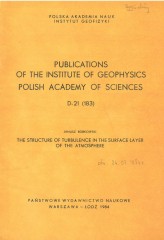- A - Physics of the Earth's Interior
- B - Seismology
-
C - Geomagnetism
C-119, C-118, C-117, C-116, C-115, C-114, C-113, C-112, C-111, C-110, C-109, C-108, C-107, C-106, C-105, C-104, C-103, C-102, C-101, C-100, C-99, C-98, C-97, C-96, C-95, C-94, C-93, C-92, C-91, C-90, C-89, C-88, C-87, C-86, C-85, C-84, C-83, C-82, C-81, C-80, C-79, C-78, C-77, C-76, C-75, C-74, C-73, C-72, C-71, C-70, C-69, C-68, C-67, C-66, C-65, C-64, C-63, C-62, C-61, C-60, C-59, C-58, C-57, C-56, C-55, C-54, C-53, C-52, C-51, C-50, C-49, C-48, C-47, C-46, C-45, C-44, C-43, C-42, C-41, C-40, C-39, C-38, C-37, C-36, C-35, C-33, C-32, C-31, C-30, C-29, C-28, C-27, C-26, C-25, C-24, C-23, C-22, C-21, C-20, C-19, C-18, C-17, C-16, C-15, C-14, C-13, C-12, C-11, C-10, C-9, C-8, C-7, C-6, C-5, C-4, C-3, C-2, C-1
-
D - Physics of the Atmosphere
D-79, D-78, D-77, D-76, D-75, D-74, D-73, D-72, D-71, D-70, D-69, D-68, D-67, D-66, D-65, D-64, D-63, D-62, D-61, D-60, D-59, D-58, D-57, D-56, D-55, D-54, D-53, D-52, D-51, D-50, D-49, D-48, D-47, D-46, D-44, D-45, D-43, D-42, D-41, D-40, D-39, D-38, D-37, D-35, D-34, D-33, D-32, D-31, D-30, D-28, D-27, D-26, D-25, D-24, D-23, D-22, D-21, D-20, D-19, D-18, D-17, D-16, D-15, D-14, D-13, D-12, D-11, D-10, D-9, D-8, D-7, D-6, D-5, D-4, D-3, D-2, D-1
- E - Hydrology
- P - Polar Research
- M - Miscellanea
-
Online First
The Structure of Turbulence in the Surface Layer of the Atmosphere
Volume: 183
Series: D-21
In the paper a model of turbulence is developed and applied to predict surface layer characteristics. The model contains equations for Reynolds stresses, turbulent heat flux, temperature variance, and turbulence energy dissipation rate. The closure is achieved by applying the gradient type hypothesis for diffusive terms, and modeling pressure terms, expressing them in terms of second order moments. The form adopted for pressure terms included also correction accounting for proximity of the underlying surface. Numerical solutions of the model equations are presented and compared with experimental data and similarity predictions. In most cases, the model predictions agree with the data reasonably well.
CONTENTS
1. Introduction, ...4
2. Basic equations, ...5
3. Modelling assumptions, ...7
4. The surface layer approximations; determination of the constants, ...13
5. Numerical scheme and boundary conditions, ...19
6. Results and discussion, ...20
7. Conclusions, ...30
References, ...30
Streszczenie, ...33


